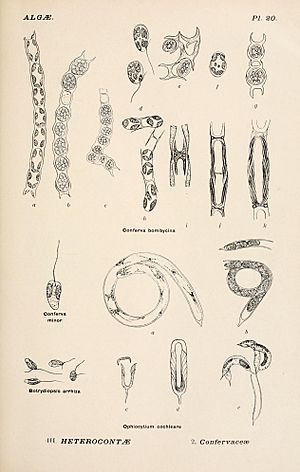Yellow-green algae facts for kids
Quick facts for kids Yellow-green algae |
|
|---|---|
 |
|
| Examples of xanthophytes (repair the unequal flagella in the cells) | |
| Scientific classification |
|
| Clade: | SAR |
| Phylum: | Ochrophyta |
| Class: | Xanthophyceae Allorge, 1930, emend. Fritsch, 1935 |
| Synonyms | |
|
|
Yellow-green algae, also called Xanthophyceae or xanthophytes, are a special group of algae. Most of them live in fresh water, like ponds and lakes. You can also find some in the ocean and in soil.
These algae come in different shapes. Some are tiny single cells that can swim using whip-like tails called flagella. Others grow in simple groups or long, thin strands.
Yellow-green algae have chloroplasts, which are like tiny factories inside their cells. These factories help them make their own food using sunlight, a process called photosynthesis. Their chloroplasts contain special colors like chlorophyll a, chlorophyll c, and beta-carotene. What makes them unique is that they don't have a pigment called fucoxanthin. This is why they look lighter in color compared to some other algae. They store their extra food as a sugar called chrysolaminarin. Their cell walls are made of cellulose and hemicellulose. Scientists think they are closely related to brown algae.
Contents
How Scientists Classify Yellow-Green Algae
For a long time, yellow-green algae were grouped with other green algae. But in 1899, a scientist named Lüther created a new group for green algae that had flagella of different lengths. This group was called Heterokontae.
Later, in 1930, another scientist named Allorge gave this group the name Xanthophyceae, which means "yellow-green algae." Over the years, scientists have continued to study and reclassify these amazing organisms.
Modern Ways to Group Yellow-Green Algae
Today, scientists often divide yellow-green algae into different orders. These orders help us understand how different types of yellow-green algae are related to each other. Here are some of the main groups:
- Botrydiales: This group includes algae like Botrydium.
- Mischococcales: This is a large group with many different forms. Examples include Ophiocytium and Pleurochloris.
- Rhizochloridales: These algae can move around like tiny amoebas. An example is Rhizochloris.
- Tribonematales: This group often forms long, thread-like structures. Tribonema is a common example.
- Vaucheriales: These are often found in freshwater and can form large mats. A well-known example is Vaucheria.
Scientists are still learning about the exact relationships between all these different types of yellow-green algae. New studies using powerful microscopes and genetic information help them understand these tiny organisms better.
Images for kids
See also
 In Spanish: Algas verde-amarillas para niños
In Spanish: Algas verde-amarillas para niños







